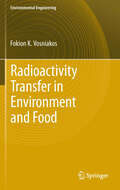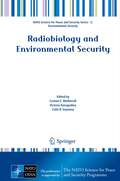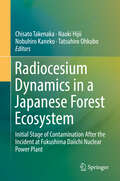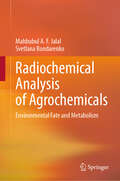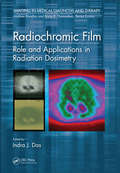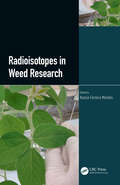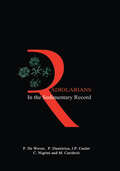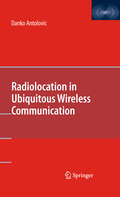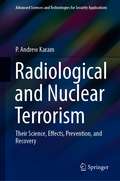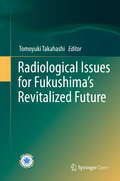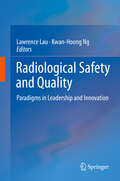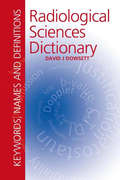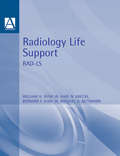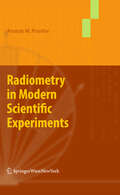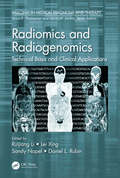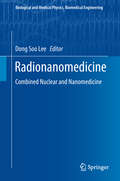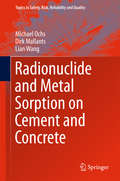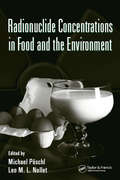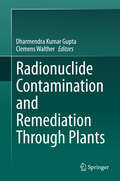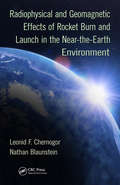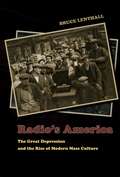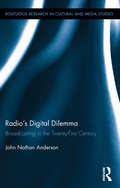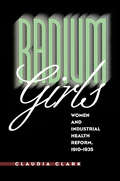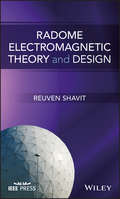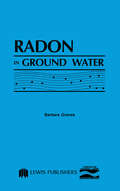- Table View
- List View
Radioactivity Transfer in Environment and Food
by Fokion K. VosniakosThe book deals with various consequences of major nuclear accidents, such as in 1986 in Chernobyl and in 2011 in Fukushima. The public is extremely interested in learning more about the movements and risks posed by radiation in the environment related to food supply and food safety. Radionuclides are found in air, water, soil and even in us not only after nuclear accidents because they occur also in nature. Every day, we ingest and inhale radionuclides in our air and food and the water. This book provides a solid underpinning of the basic physical-chemistry and biogeochemistry of naturally occurring and anthrop radioactivity. The mechanisms of radioactive element transfer in the atmosphere, tropospheric and stratospheric diffusion of radioactivity, environmental contamination from accidents and the impact of atmospheric pollution on the food chain, soil and plants, are analyzed and the analytical methods are illustrated. The question of natural radioactivity concentration in building materials is addressed too. While the book contains many case studies and data for Greece, it is of general value. It contributes to the development of international environmentally safe standards and economically reasonable standard regulations based on justified radiological, social and economical legislation concepts.
Radiobiology and Environmental Security
by Carmel E Mothersill Colin B. Seymour Victoria KorogodinaThis volume - like the NATO Advanced Research Workshop on which it is based - addresses the fundamental science that contributes to our understanding of the potential risks from ecological terrorism, i.e. dirty bombs, atomic explosions, intentional release of radionuclides into water or air. Both effects on human health (DNA and systemic effects) and on ecosystems are detailed, with particular focus on environmentally relevant low-dose ranges. The state-of-the-art contributions to the book are authored by leading experts; they tackle the relevant questions from the perspectives of radiation genetics, radiobiology, radioecology, radiation epidemiology and risk assessment.
Radiocesium Dynamics in a Japanese Forest Ecosystem: Initial Stage of Contamination After the Incident at Fukushima Daiichi Nuclear Power Plant
by Chisato Takenaka Naoki Hijii Nobuhiro Kaneko Tatsuhiro OhkuboThis book investigates radiocesium movement in all major components of forest ecosystems, e.g. the plants, animals, insects, microorganisms, and soils, during the initial stage of contamination after the incident at Fukushima Daiichi Nuclear Power Plant. Most of the work was conducted at a common research site.More specifically, the book examines the contribution of surface uptake by trees in the dynamics of radiocesium during the initial contamination stage; the movement of radiocesium in the form of small organic fragments that are essential to the radiocesium dynamics in forest ecosystems; and the upward movement of radiocesium due to microorganism activity, which promotes the effective decontamination of the forest floor. Lastly, it explains why spiders could be a valuable indicator of the contamination level in forest ecosystems.
Radiochemical Analysis of Agrochemicals: Environmental Fate and Metabolism
by Mahbubul A. Jalal Svetlana BondarenkoThis book provides an in-depth overview of agrochemicals, their development, regulation, and environmental impact. It also offers detailed insights into the latest research methodologies and regulatory standards. Through this comprehensive guide, readers will gain a thorough understanding of the complexities surrounding agrochemical use and its implications for modern agriculture. The chapters cover a wide range of topics including the history and evolution of crop protection methods, the regulatory framework governing agrochemicals, and the intricate processes of degradation and metabolism in various environments. Expert contributors discuss the nuances of radioactivity in agrochemical studies, quantitative and spectroscopic analysis techniques, and the behaviour of these chemicals in soil, water, plants, and livestock. Given its breadth, this book appeals to academics, practitioners, policymakers, and students interested in understanding the scientific principles and practical applications of agrochemicals. Researchers in the fields of agricultural science, environmental chemistry, and regulatory affairs will find this book invaluable.
Radiochromic Film: Role and Applications in Radiation Dosimetry (Imaging in Medical Diagnosis and Therapy)
by Indra J. DasThis book provides a first authoritative text on radiochromic film, covering the basic principles, technology advances, practical methods, and applications. It focuses on practical uses of radiochromic film in radiation dosimetry for diagnostic x-rays, brachytherapy, radiosurgery, external beam therapies (photon, electron, protons), stereotactic body radiotherapy, intensity-modulated radiotherapy, and other emerging radiation technologies. <P><P>The expert authors address basic concepts, advantages, and the main applications including kilovoltage, brachytherapy, megavoltage, electron beam, proton beam, skin dose, in vivo dosimetry, postal and clinical trial dosimetry. The final chapters discuss the state of the art in microbeam, synchrotron radiation, and ultraviolet radiation dosimetry.
Radioisotopes in Weed Research
by Kassio Ferreira MendesHerbicides are of great importance in weed management and are one of the most widely used pesticide groups for weed control across the globe. Concerns around the residual effects of these intensively used chemicals are equally widespread. Offering a new direction for research that focuses on herbicide behavior and its impacts on the environment, this book covers the use of radioisotopes in weed research and the detoxification of herbicides. Applying technological advances in radiation detection, Radioisotopes in Weed Research explains how isotopic techniques can be used to identify degradation products and trace the fate of herbicides applied to crop plants. This book provides essential information on the historical use and recent advances of radioisotopes in weed research. It demonstrates the potential these methods offer the field of weed science in gaining a better understanding of the behavior of herbicides in plants and soil and working to ensure the continuous, effective, and safe use of herbicides, minimizing harmful impacts on ecosystems. Features: Explains the radiometric method with studies of radiolabelled herbicides and includes case studies as examples Describes radiometric methods to study the behavior of herbicides in soil from transport and transformation to retention Elucidates the absorption, translocation, and metabolism studies of herbicides in plants Authored by a team of leading scientists, this book is written for professors, researchers, extensionists, graduate and undergraduate students, rural producers, and other professionals involved in weed science.
Radiolarians in the Sedimentary Record
by P. De Wever P. Dumitrica J.P. Caulet C. Nigrini M. CaridroitRadiolarians in the Sedimentary Record presents the current state of knowledge on fossil radiolarians. The author discusses the record, as well as new integrated taxonomic systems at the family level. The book provides comprehensive coverage of the fossil record of these unicellular organisms. It also discusses their important role in the history o
Radiolocation in Ubiquitous Wireless Communication
by Danko AntolovicThe subject of the book is application of multi-antenna radiolocation to the environment of fast, ubiquitous wireless communication among portable devices. It is a systematic presentation of the author's research and development in the field, within the 802.11b standard, while explaining the general principles and exploring applications to other standards and situations. The purpose is to fill a gap in the current technical literature and present the issues involved in locating mobile wireless network agents, in a single volume, accessible to system designers and other practitioners in the wireless field.
Radiological and Nuclear Terrorism: Their Science, Effects, Prevention, and Recovery (Advanced Sciences and Technologies for Security Applications)
by P. Andrew KaramThis book discusses multiple aspects of radiological and nuclear terrorism. Do you know what to do if there is a radiological or nuclear emergency in your city? These accidents are not common, but they have happened – and even though we have not seen an attack using these weapons, governments around the world are making plans for how to prevent them – and for how to respond if necessary. Whether you are an emergency responder, a medical caregiver, a public health official – even a member of the public wanting to know how to keep yourself and your loved ones safe – there is a need to understand how these weapons work, how radiation affects our health, how to stop an attack from taking place, how to respond appropriately in the event of an emergency, and much more.Unfortunately, the knowledge that is needed to accomplish all of this is lacking at all levels of society and government. In this book, Dr. Andrew Karam, an internationally respected expert in radiation safety and multiple aspects of radiological and nuclear emergencies, discusses how these weapons work and what they can do, how they can affect our health, how to keep yourself safe, and how to react appropriately whether you are a police officer investigating a suspect radiological weapon, a firefighter responding to a radiological or nuclear attack, a nurse or physician caring for potentially contaminated patients, or a governmental official trying to keep the public safe. To do this, he draws upon his extensive experience in the military, the several years he worked directly with emergency responders, his service on a number of advisory committees, and multiple trips overseas in the aftermath of the Fukushima accident and on behalf of the International Atomic Energy Agency, Interpol, and the Health Physics Society.
Radiological Issues for Fukushima's Revitalized Future
by Tomoyuki TakahashiThis book overviews environmental issues 4 years after the Fukushima nuclear accident, covering a wide range of areas related to radiation and radioactivity. The topics discussed are necessary to make clear the relationship between the results of research and Fukushima's revitalized future. The chapters are divided into four parts: Part 1 presents the identification of radionuclides in soil and migration of radionuclides in the terrestrial environment; Part 2 describes the safety decontamination system and treatment of radioactive waste; Part 3 explains the development of the system of measurement of environmental radiation and evaluation of external exposure; and Part 4 discusses the identification of radionuclides in farm products, control of root uptake, identification of decreasing radionuclides by food processing, and evaluation of internal exposure. Since the accident at the Tokyo Electric Power Company's Fukushima Daiichi nuclear power station in 2011, gradual steps have been taken toward environmental recovery in the area. However, there are still many issues that need to be tackled in order to achieve the full revitalization of Fukushima. These issues encompass many different disciplines such as economics, psychology, and sociology. In this kind of situation, the role of science in relation to radiation and radioactivity is especially important. This book aims to contribute to planning countermeasures against nuclear disasters in the future. It will be of particular interest to governmental officials who are engaged with the Fukushima nuclear accident; researchers, including those in international sectors, who are interested in radiological issues; and those who need comprehensive and reliable information about the Fukushima accident.
Radiological Safety and Quality
by Lawrence Lau Kwan-Hoong NgThis book is the product of a unique collaboration by experts from leading international, regional and national agencies and professional organizations discussing on the current 'hot' issue on the judicious use and safety of radiation in radiology. There have been several cases involving radiation overexposure that have received international attention. Strategies and solutions to guide readers how to maximize the benefits and minimize the risks when using radiation in medicine are covered.
Radiological Sciences Dictionary: Keywords, names and definitions
by David DowsettThe Radiological Sciences Dictionary is a rapid reference guide for all hospital staff employed in diagnostic imaging, providing definitions of over 3000 keywords as applied to the technology of diagnostic radiology.Written in a concise and easy to digest form, the dictionary covers a wide variety of subject matter, including:a radiation legislati
Radiology Life Support (RAD-LS): A Practical Approach
by William Bush Jr'Radiology Life Support' focuses on the adverse effects and life-threatening emergencies caused by reactions to the contrast media used in every modern radiology department. Such reactions are relatively infrequent yet can be severe and are therefore difficult to identify and then handle safely without training. All radiologists will experience at least a few such reactions throughout their career. This book teaches proper recognition and treatment of adverse contrast reactions, proper use of sedation and analgesic agents, proper management of an airway in an emergency situation and principle concepts in basic and advanced life support (including early defibrilation). The text is based on the successful training course run by the editors and sponsored by the American Roentgen Ray Society. Adverse reactions to contrast agents are somewhat difficult for physicians without practice to identify and then handle effectively. This volume is a useful aid to the identification process.
Radiometry in Modern Scientific Experiments
by Pravilov AnatolyThe reader is provided with information about methods of calibration of light sources and photodetectors as well as responsiveness of spectral instruments ranging from near infrared to vacuum UV spectral, 1200 - 100 nm, and radiation intensities of up to several quanta per second in absolute and arbitrary units. The author describes for the first time original methods of measurements they created and draws upon over 40 years of experience in working with light sources and detectors to provide accurate and precise measurements. This book is the first to cover these aspects of radiometry and is divided into seven chapters that examine information about terminology, units, light sources and detectors, methods, including author's original ones, of absolute calibration of detectors, spectral instruments responsiveness, absolute measurements of radiation intensity of photoprocesses, and original methods of their study. Of interest to researchers measuring; luminescence spectra, light intensities from IR to vacuum UV, spectral range in wide-light intensity ranges, calibrate light sources and detectors, absolute or relative quantum yields of photoprocess determination.
Radiomics and Radiogenomics: Technical Basis and Clinical Applications (Imaging in Medical Diagnosis and Therapy)
by Ruijiang Li, Lei Xing, Sandy Napel and Daniel L. RubinRadiomics and Radiogenomics: Technical Basis and Clinical Applications provides a first summary of the overlapping fields of radiomics and radiogenomics, showcasing how they are being used to evaluate disease characteristics and correlate with treatment response and patient prognosis. It explains the fundamental principles, technical bases, and clinical applications with a focus on oncology. The book’s expert authors present computational approaches for extracting imaging features that help to detect and characterize disease tissues for improving diagnosis, prognosis, and evaluation of therapy response. This book is intended for audiences including imaging scientists, medical physicists, as well as medical professionals and specialists such as diagnostic radiologists, radiation oncologists, and medical oncologists. Features Provides a first complete overview of the technical underpinnings and clinical applications of radiomics and radiogenomics Shows how they are improving diagnostic and prognostic decisions with greater efficacy Discusses the image informatics, quantitative imaging, feature extraction, predictive modeling, software tools, and other key areas Covers applications in oncology and beyond, covering all major disease sites in separate chapters Includes an introduction to basic principles and discussion of emerging research directions with a roadmap to clinical translation
Radionanomedicine: Combined Nuclear And Nanomedicine (Biological and Medical Physics, Biomedical Engineering)
by Dong Soo LeeThis book describes radionanomedicine as an integrated medicine using exogenous and endogenous This book describes radionanomedicine as an integrated approach that uses exogenous and endogenous nanomaterials for in vivo and human applications. It comprehensively explains radionanomedicine comprising nuclear and nanomedicine, demonstrating that it is more than radionanodrugs and that radionanomedicine also takes advantage of nuclear medicine using trace technology, in which miniscule amounts of materials and tracer kinetic elucidate in vivo biodistribution. It also discusses exogenous nanomaterials such as inorganic silica, iron oxide, upconversion nanoparticles and quantum dots or organic liposomes labelled with radioisotopes, and radionanomaterials used for targeted delivery and imaging for theranostic purposes. Further, it examines endogenous nanomaterials i.e. extracellular vesicles labelled with radioisotopes, known as radiolabelled extracellular vesicles, as well as positron emission tomography (PET) and single photon emission computed tomography (SPECT), which elucidate the biodistribution and potential for therapeutic success.
Radionuclide and Metal Sorption on Cement and Concrete
by Michael Ochs Dirk Mallants Lian WangCementitious materials are being widely used as solidification/stabilisation and barrier materials for a variety of chemical and radioactive wastes, primarily due to their favourable retention properties for metals, radionuclides and other contaminants. The retention properties result from various mineral phases in hydrated cement that possess a high density and diversity of reactive sites for the fixation of contaminants through a variety of sorption and incorporation reactions. This book presents a state of the art review and critical evaluation of the type and magnitude of the various sorption and incorporation processes in hydrated cement systems for twenty-five elements relevant for a broad range of radioactive and industrial wastes. Effects of cement evolution or ageing on sorption/incorporation processes are explicitly evaluated and quantified. While the immobilisation of contaminants by mixing-in during hydration is not explicitly addressed, the underlying chemical processes are similar. A quantitative database on the solid/liquid distribution behaviour of radionuclides and other elements in hydrated cement systems is established on the basis of a consistent review and re-evaluation of literature data. In addition to recommended values, all underlying original experimental data and key experimental info rmation are provided, which allows users to trace the given recommendations or to develop their own set of key values. This database is closely tied to the safety analysis of near surface disposal of radioactive waste in Belgium. It focuses on radioelements, toxic stable elements and heavy metals, which makes it relevant for investigations involving the interaction of radioactive and conventional contaminants with cement-based barriers.
Radionuclide Concentrations in Food and the Environment
by Leo M. L. Nollet Michael PoschlAs radiological residue, both naturally occurring and technologically driven, works its way through the ecosystem, we see its negative effects on the human population. Radionuclide Concentrations in Food and the Environment addresses the key issues concerning the relationship between natural and manmade sources of environmental radioactivity
Radionuclide Contamination and Remediation Through Plants
by Dharmendra Kumar Gupta Clemens WaltherThis book focuses on the mechanistic (microscopic) understanding of radionuclide uptake by plants in contaminated soils and potential use of phytoremediation. The key features concern radionuclide toxicity in plants, how the radioactive materials are absorbed by plants, and how the plants cope with the toxic responses. The respective chapters examine soil classification, natural plant selection, speciation of actinides, kinetic modeling, and case studies on cesium uptake after radiation accidents. Radionuclide contaminants pose serious problems for biological systems, due to their chemical toxicity and radiological effects. The processes by which radionuclides can be incorporated into vegetation can either originate from activity interception by external plant surfaces (either directly from the atmosphere or from resuspended material), or through uptake of radionuclides via the root system. Subsequent transfer of toxic elements to the human food chain is a concrete danger. Therefore, the molecular mechanisms and genetic basis of transport into and within plants needs to be understood for two reasons: The effectiveness of radionuclide uptake into crop plants - so-called transfer coefficient - is a prerequisite for the calculation of dose due to the food path. On the other hand, efficient radionuclide transfer into plants can be made use of for decontamination of land - so-called phytoremediation, the direct use of living, green plants for in situ removal of pollutants from the environment or to reduce their concentrations to harmless levels.
Radiophysical and Geomagnetic Effects of Rocket Burn and Launch in the Near-the-Earth Environment
by Leonid F. Chernogor Nathan BlaunsteinRadiophysical and Geomagnetic Effects of Rocket Burn and Launch in the Near-the-Earth Environment describes experimental and theoretical studies on the effects of rocket burns and launchings on the near-the-Earth environment and geomagnetic fields. It illuminates the main geophysical and radiophysical effects on the ionosphere and magnetosphere sur
Radio's America: The Great Depression and the Rise of Modern Mass Culture (Studies In Communication, Media, And Public Opinion Ser.)
by Bruce LenthallOrson Welles’s greatest breakthrough into the popular consciousness occurred in 1938, three years before Citizen Kane, when his War of the Worlds radio broadcast succeeded so spectacularly that terrified listeners believed they were hearing a genuine report of an alien invasion—a landmark in the history of radio’s powerful relationship with its audience. In Radio’s America, Bruce Lenthall documents the enormous impact radio had on the lives of Depression-era Americans and charts the formative years of our modern mass culture. Many Americans became alienated from their government and economy in the twentieth century, and Lenthall explains that radio’s appeal came from its capability to personalize an increasingly impersonal public arena. His depictions of such figures as proto-Fascist Charles Coughlin and medical quack John Brinkley offer penetrating insight into radio’s use as a persuasive tool, and Lenthall’s book is unique in its exploration of how ordinary Americans made radio a part of their lives. Television inherited radio’s cultural role, and as the voting tallies for American Idol attest, broadcasting continues to occupy a powerfully intimate place in American life. Radio’s America reveals how the connections between power and mass media began.
Radio's Digital Dilemma: Broadcasting in the Twenty-First Century (Routledge Research in Cultural and Media Studies #60)
by John Nathan AndersonRadio's Digital Dilemma is the first comprehensive analysis of the United States’ digital radio transition, chronicling the technological and policy development of the HD Radio broadcast standard. A story laced with anxiety, ignorance, and hubris, the evolution of HD Radio pitted the nation’s largest commercial and public broadcasters against the rest of the radio industry and the listening public in a pitched battle over defining the digital future of the medium. The Federal Communications Commission has elected to put its faith in "marketplace forces" to govern radio’s digital transition, but this has not been a winning strategy: a dozen years from its rollout, the state of HD Radio is one of dangerous malaise, especially as newer digital audio distribution technologies fundamentally redefine the public identity of "radio" itself. Ultimately, Radio’s Digital Dilemma is a cautionary tale about the overarching influence of economics on contemporary media policymaking, to the detriment of notions such as public ownership and access to the airwaves—and a call for media scholars and reformers to engage in the continuing struggle of radio’s digital transition in hopes of reclaiming these important principles.
Radium Girls: Women and Industrial Health Reform, 1910–1935
by Claudia ClarkIn the early twentieth century, a group of women workers hired to apply luminous paint to watch faces and instrument dials found themselves among the first victims of radium poisoning. Claudia Clark's book tells the compelling story of these women, who at first had no idea that the tedious task of dialpainting was any different from the other factory jobs available to them. But after repeated exposure to the radium-laced paint, they began to develop mysterious, often fatal illnesses that they traced to conditions in the workplace. Their fight to have their symptoms recognized as an industrial disease represents an important chapter in the history of modern health and labor policy. <p><p> Clark's account emphasizes the social and political factors that influenced the responses of the workers, managers, government officials, medical specialists, and legal authorities involved in the case. She enriches the story by exploring contemporary disputes over workplace control, government intervention, and industry-backed medical research. Finally, in appraising the dialpainters' campaign to secure compensation and prevention of further incidents--efforts launched with the help of the reform-minded, middle-class women of the Consumers' League--Clark is able to evaluate the achievements and shortcomings of the industrial health movement as a whole.
Radome Electromagnetic Theory and Design (Wiley - IEEE)
by Reuven ShavitRadome Electromagnetic Theory and Design explores the theoretical tools and methods required to design radomes that are fully transparent to the electromagnetic energy transmitted or received by the enclosed antenna. A radome is a weatherproof and camouflaged enclosure that protects the enclosed radar or communication antenna, and are typically used on a fixed or moving platform such as an aircraft, ship or missile. The author — a noted expert in the field — examines the theoretical methods that apply to all type of radomes: planar, conformal, airborne and ground based. The text offers a description of the various measurement methods that characterise the electrical parameters of a radome, and discusses their merits in terms of accuracy. This groundbreaking book brings together in one volume all the necessary theoretical tools to design radomes
Radon in Ground Water
by National Water Well Assoc.This new book focuses on sampling and analysis, radon and radium in water supply wells, predictive models, geologic and hydrogeologic controls that influence radon occurrence, monitoring radon and other radioactivity from geologic sources and mining impacts on occurrence of radioactivity in ground water. Also discussed are occurrence, testing, treatment, and reduction of radon from groundwater. Because the most severe health hazard from indoor radioactivity results from inhalation of short-lived radioactive decay products of radon, the EPA scheduled a major conference early in 1987 on Radon, Radium, and Other Radioactivity in Ground Water-Hydrogeologic Impact and Application to Indoor Airborne Contamination. The result is this book.
